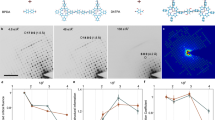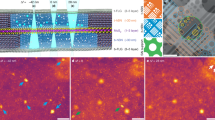Abstract
A range of water-insoluble materials, when spread from a solvent onto an air–water interface, form monolayers, Langmuir films, which can be built up on a solid substrate to give well-defined multilayer coatings, Langmuir–Blodgett (L–B) films, resembling fatty-acid layers1–3. These L–B films have aroused intense interest because of their potential applications as electrically-active materials4, optical elements5 and electron beam resists6, for which it would be very useful to know the structure of the monolayers. Although significant structural information has been derived from electron diffraction studies, an electron micrograph would be ideal; because of the fragility of conventional materials and their degradation in the electron beam, however, such imaging has not been achieved till now. (Electron micrographs of L–B films of the heavy-metal complex Th[(CF3CO) 2CH]4 have been reported7, but the films were not single monolayers.) We present here the first electron micrographs of a single monolayer.
This is a preview of subscription content, access via your institution
Access options
Subscribe to this journal
Receive 51 print issues and online access
$199.00 per year
only $3.90 per issue
Buy this article
- Purchase on Springer Link
- Instant access to full article PDF
Prices may be subject to local taxes which are calculated during checkout
Similar content being viewed by others
References
Langmuir, I. J. Am. chem. Soc. 39, 1848–1906 (1917).
Langmuir, I. Trans. Faraday. Soc. 15, 62–75 (1920).
Blodgett, K. B. J. Am. chem. Soc. 57, 1007–1022 (1935).
Vincett, P. S. & Roberts, G. G. Thin Solid Films 68, 135–171 (1980).
Pitt, C. W. & Walpita, L. M. Thin Solid Films 68, 101–127 (1980).
Barraud, A. Thin Solid Films 99, 317–321 (1983).
Baumeister, W. & Hahn, M. Cytobiologie 7, 244–264 (1973).
Baker, S., Petty, M. C., Roberts, G. G. & Twigg, M. V. Thin Solid Films 99, 53–59 (1983).
Hann, R. A. et al. Proc. 2nd Int. Workshop Molecular Electron. Devices (Washington, April 1983) (in the press).
Murata, Y., Fryer, J. R. & Baird, T. Nature 263, 401–402 (1976).
Fryer, J. R. Acta crystallogr. A35, 327–332 (1979).
Roberts, G. G., McGinnity, T. M., Barlow, W. A. & Vincent, P. S. Thin Solid Films 68, 223–232 (1980).
O'Keefe, M. A., Fryer, J. R. & Smith, D. J. Acta crystallogr. A39, 838–847 (1983).
Fryer, J. R. J. Microsc. 120, 1–14 (1980).
Naegele, D., Lando, J. B. & Ringsdorf, H. Macromolecules 10, 1339–1344 (1977).
Grunfeld, F. & Pitt, C. W. Thin Solid Films 99, 249–255 (1983).
Author information
Authors and Affiliations
Rights and permissions
About this article
Cite this article
Fryer, J., Hann, R. & Eyres, B. Single organic monolayer imaging by electron microscopy. Nature 313, 382–384 (1985). https://doi.org/10.1038/313382a0
Received:
Accepted:
Issue Date:
DOI: https://doi.org/10.1038/313382a0
This article is cited by
Comments
By submitting a comment you agree to abide by our Terms and Community Guidelines. If you find something abusive or that does not comply with our terms or guidelines please flag it as inappropriate.



